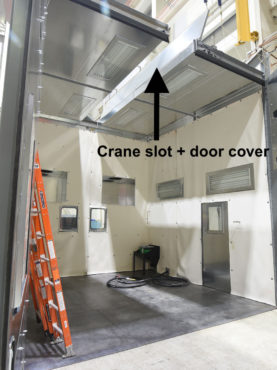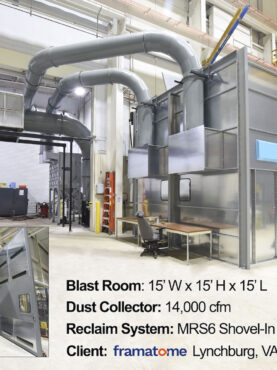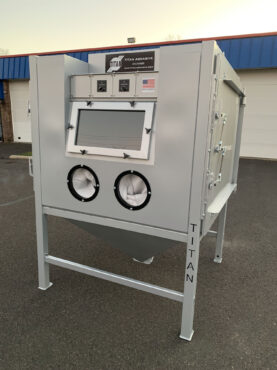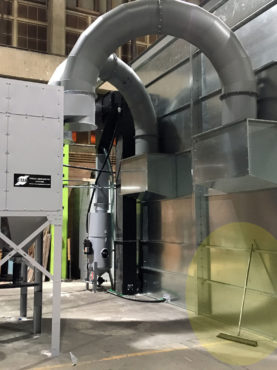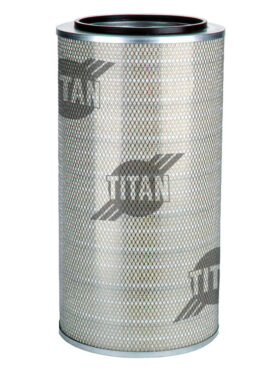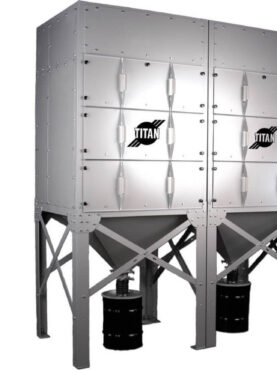

Blast Room Walk Around: The Components that Make Up a Titan Blast System
Want to know what a Titan Abrasive blast room system looks and sounds like? Follow along with the video and time stamps as I take you through a recent blast room installation and its various components.
01 to 11 seconds – Blast room exterior and LED lights
As we walk toward the blast room, you see the exterior panels. These are made of US-sourced, galvanized steel, available in 14 or 11 gauge.
As we round the corner, you see the light fixtures. All Titan blast rooms come standard with rear (or external) access light fixtures comprised of six, 48-inch LED tubes with polycarbonate lens.
These LED lights, which are also made in the USA, withstand the harshest blasting environments.
Why are the light panels blue? This is actually the protective paper that prevents scratching. It hadn’t been removed yet.
12 to 31 seconds – Control panel
Opening the door, we’re now in the blast room. You’ll catch a quick glimpse of the LED lights and walls.
Heading over to the control panel, I press the green button to turn on the bucket elevator, which feeds the blast machine (25 seconds).
I also turn on the dust collector – that’s the loud woooooo sound you hear. It’s actually the blower for the dust collector that makes the noise.
32 to 40 seconds – Overhead ducting
Heading to the back of the room, we go by the blast machine. You see the dust collector blower (black unit with the gold motor) and the dust collector.
You’ll also catch a quick peek (35 seconds) of the large duct work behind the dust collector at floor level – it connects the dust collector to the blower. You’ll see a much better view at 1:32.
Looking up, you can view the overhead ducting for the dust collector. (This is why ceiling height is such an important consideration when designing your blast room!)
Dust is sucked out of the blast room and into the Titan cartridge dust collector, which features a reverse pulse cleaning system. This system momentarily reverses the air flow through the filter element and knocks the caked-on dust into the hopper while the collector is in operation.
Hence, no dust build-up on your filter cartridges!
41 to 49 seconds – Breathing air filter
As we head back into the blast room, you’ll catch a view of the bucket elevator. On the way, pause the video at 49 – 50 seconds for a quick view of the canister which holds the breathing air filter. A green breathing air hose attaches to it and to the operator helmet.
All shops have air tools; the lines to these tools are usually red or black. The green air line stands apart and is an OSHA-mandated safety feature. The line feeds air into the operator helmet.
50 to 58 seconds – Back to the control panel
Walking back to the control panel, I shut everything off and stop by the CO monitor.
59 seconds to 1:07 – CO gas monitor
Next stop is the gas monitor, another OSHA-mandated safety feature for monitoring carbon monoxide levels in the air feeding the operator helmet. Although the gas monitor is connected to breathing air filter, which filters out sediment and other debris, the air filter can’t detect or remove carbon monoxide.
Customers can elect to add up to three additional gas monitors or plugs, depending on their needs.
You can see the main air lines, ball valve, etc.
1:07 to 1:29 – Dust collectors and duct work
Walking around to the back side of the blast room, you get another view of the dust collector and duct work. This blast room incorporates two of our modular dust collector segments.
Be sure to read our Tech Tip about duct work and why you need the proper elbow radius for optimal air flow.
1:30 to 1:50 – Ducting for the blower
Now you get a close up of the 30” diameter duct that connects the dust collector to the blower (the big black structure) and another look at the motor. Everything looks good!
And that is a very fast tour of a Titan blast room – one of the many custom jobs Titan designs, fabricates, and installs on a regular basis.
If you need a custom blast room to solve your unique challenge, contact us. You’ll talk directly with one of our expert blast room engineers – no middlemen involved!

Brandon Acker: President
Brandon purchased Titan Abrasive from his uncle and founder in 2013. Titan has since redesigned its entire product line to solve dozens of industry challenges.
Brandon purchased Titan Abrasive from his uncle and Titan founder, Bruce Maurer, in 2013 after spending five years learning the ins and outs of the business. He and VP of Engineering Brian Fox have completely redesigned the entire product line to solve the dozens of challenges that have plagued the blasting industry for decades.
Brandon is passionate about American manufacturing, the jobs it creates, the quality produced, and the bright future that lies ahead. He’s a frequent guest on manufacturing podcasts where he shares his deep industry expertise. Brandon holds a Bachelor of Science degree from Arizona State University.


